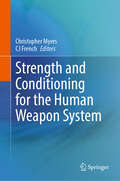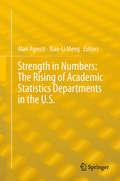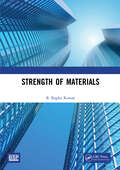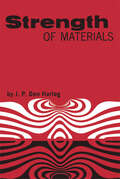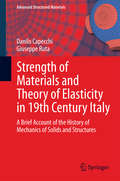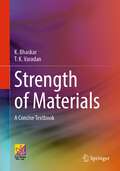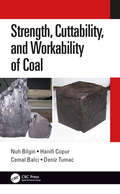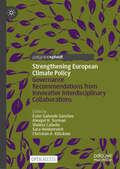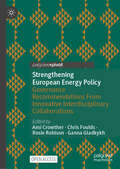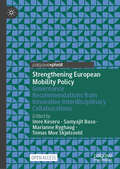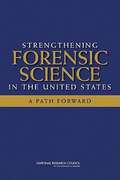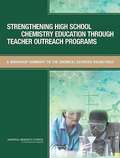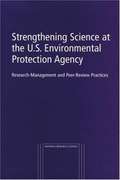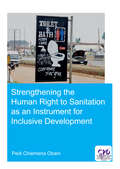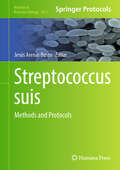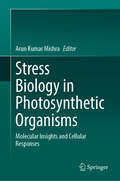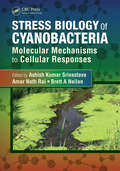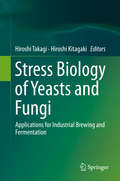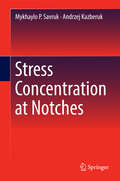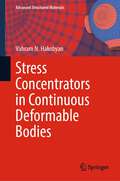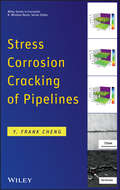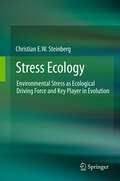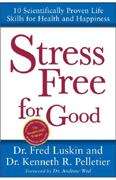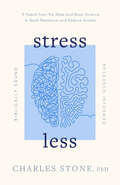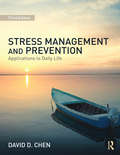- Table View
- List View
Strength and Conditioning for the Human Weapon System
by Christopher Myers Cj FrenchA central focus of the US Military is the Human Weapon System (HWS) and the optimization of this weapon system. Over the past decade, the Department of Defence has invested in programs termed Human Performance Optimization (HPO) programs. Human performance for the human weapon system is much different than the civilian athlete. Therefore, the human weapon system's rehabilitation and performance training requirements are different and must be considered. This book demonstrates the following to strength coaches and practitioners: Why to view the HWS as a multi-faceted system that requires a more inclusive program than needed by athletes. Provide updated methodology to create a strength and conditioning program specifically for the HWS populations. Introduce and define advanced strength and conditioning methodologies SC professionals use within the US Military and law enforcement performance programs.
Strength in Numbers: The Rising of Academic Statistics Departments in the U. S.
by Alan Agresti Xiao-Li MengStatistical science as organized in formal academic departments is relatively new. With a few exceptions, most Statistics and Biostatistics departments have been created within the past 60 years. This book consists of a set of memoirs, one for each department in the U.S. created by the mid-1960s. The memoirs describe key aspects of the department's history -- its founding, its growth, key people in its development, success stories (such as major research accomplishments) and the occasional failure story, PhD graduates who have had a significant impact, its impact on statistical education, and a summary of where the department stands today and its vision for the future. Read here all about how departments such as at Berkeley, Chicago, Harvard, and Stanford started and how they got to where they are today. The book should also be of interests to scholars in the field of disciplinary history.
Strength of Materials
by B. Raghu KumarThis book follows a simple approach, and introduces analytical procedures to analyze various structural members subjected to different types of loading with step-by-step problem-solving procedure is discussed.The book covers some advanced topics like curved beams, shear center, unit load method. Aa exclusive chapter on "Solving through ANSYS" covers the approach and usage of ANSYS software. Note: T& F does not sell or distribute the Hardback in India, Pakistan, Nepal, Bhutan, Bangladesh and Sri Lanka.
Strength of Materials (Dover Books on Physics)
by J. P. HartogAmong introductory texts on the strength of materials, this work is particularly distinguished. It was originally developed by Professor Den Hartog to meet the needs of engineering students at M.I.T. for a sound yet lucid first course in strength of materials. As such it has also enjoyed wide popularity in engineering schools throughout the world.But the book was remarkable in a number of other ways, so that it has become one of the favorite refresher and reference works for engineers as well as a popular self-study text. Perhaps the chief reason for this is that in addition to all the customary elementary material on the subject (i.e., clear instructions to the fundamentals of tension, torsion, bending, compound stresses, deflection of beams, etc.) it also contains a considerable amount of more advanced material concerning methods of great practical value to working engineers which are not usually included in introductory texts. This material is presented in starred sections (which may be omitted on a first reading without interrupting the flow of the presentation) and includes a full treatment of the Mohr circle and its application to the determination of moments of inertia and strains as well as stresses; a lucid elementary presentation of the theory of the center of shear; and one of the few elementary presentations of the theory of the center of shear; and one of the few elementary discussions of the "Myosotis" method of calculating beam deflections, a method which often possesses considerable advantages over the more usual methods involving moment-area or the differential equation of bending.Other material not usually found in elementary texts but which are frequently of great value to the practicing engineer are the discussions of the statically indeterminate truss, reinforced concrete, plastic deformations, thick-walled cylinders, thick curved bars, Maxwell's Reciprocal Theorem, and photoelasticity.In all sections, both general principles and concrete applications are given. Another feature which readers have found unusually helpful is the 85-page section of 350 problems which gives the student practice in techniques and further illustrates applications. All problems are complete with answers.
Strength of Materials and Theory of Elasticity in 19th Century Italy
by Danilo Capecchi Giuseppe RutaThis book examines the theoretical foundations underpinning the field of strength of materials/theory of elasticity, beginning from the origins of the modern theory of elasticity. While the focus is on the advances made within Italy during the nineteenth century, these achievements are framed within the overall European context. The vital contributions of Italian mathematicians, mathematical physicists and engineers in respect of the theory of elasticity, continuum mechanics, structural mechanics, the principle of least work and graphical methods in engineering are carefully explained and discussed. The book represents a work of historical research that primarily comprises original contributions and summaries of work published in journals. It is directed at those graduates in engineering, but also in architecture, who wish to achieve a more global and critical view of the discipline and will also be invaluable for all scholars of the history of mechanics.
Strength of Materials: A Concise Textbook
by K. Bhaskar T. K. VaradanThis textbook has been written for the engineering students. This textbook covers the essentials of solid mechanics with reference to basic load-bearing members—straight bars, thin-walled cylindrical and spherical pressure vessels, circular shafts, beams undergoing simple bending, and columns. It concisely elucidates the corresponding fundamental assumptions, important equations, and their range of validity without formal derivations. Subsequently, this textbook contains several carefully selected examples to illustrate sequence of steps in the analysis of forces, stresses and displacements, or stability. It further deals with combined loading, stress and strain transformations, energy methods, and failure analysis using commonly employed criteria. This textbook is a handy, yet complete, resource for graduate and postgraduate engineering students. It will also be a ready reference for a practicing engineers or graduate students preparing for an interview or a competitive examination.
Strength, Cuttability, and Workability of Coal
by Nuh Bilgin Hanifi Copur Cemal Balci Deniz TumacWorld coal production will increase up to 2040 and world energy consumption will be very much dependent on coal. For a better planning of coal mining operations, it is essential to know the strength, cuttability and workability of coal, which are interrelated. The main objective of the book is to combine the research studies and compile the book oriented to the coal industry, research students, practicing engineers, and coal mine panning teams. Key Features Covers all the subjects related to coal properties, mining and excavation in one book Presents a summary of physical and mechanical properties of coal belonging to a wide range of countries Includes typical examples of using physical and mechanical of coal in mine planning and in its industrial applications Explains use of cuttability characteristics of coal Describes planning of coal production using ploughs, shearers and surface miners
Strengthening European Climate Policy: Governance Recommendations from Innovative Interdisciplinary Collaborations
by Christian A. Klöckner Ester Galende Sánchez Alevgul H. Sorman Violeta Cabello Sara HeidenreichThis open-access book foregrounds 10 novel collaborations between the Social Sciences and Humanities (SSH), and Science, Technology, Engineering and Mathematics (STEM) disciplines, for strengthening European climate policy. Part of a three-volume collection covering climate, energy, and mobility policy.
Strengthening European Energy Policy: Governance Recommendations From Innovative Interdisciplinary Collaborations
by Chris Foulds Rosie Robison Ami Crowther Ganna GladkykhThis open access book foregrounds novel collaborations between the Social Sciences and Humanities (SSH), and Science, Technology, Engineering and Mathematics (STEM) disciplines, for the benefit of European energy policy. Each chapter has been led by a team spanning social and technical disciplines. The book proposes 10 policy recommendations to: Simplify the uptake of community energy; Prioritise societal engagement in geothermal; Create co-learning for energy communities; Facilitate energy literacy; Support place-based strategies for retrofit; Promote integrated policy design for agrivoltaics; Increase social acceptability of low-carbon technologies; Protect digital energy infrastructure; Understand stakeholder perceptions of energy-efficiency measures; and Rethink energy system models to support the just transition. It will be of interest to anyone developing, implementing or critiquing energy policy (locally, nationally or internationally) as well as those looking to expand the use of interdisciplinary research to achieve sustainability goals. Part of a three-volume collection covering climate, energy, and mobility policy.
Strengthening European Mobility Policy: Governance Recommendations from Innovative Interdisciplinary Collaborations
by Marianne Ryghaug Tomas Moe Skjølsvold Imre Keseru Samyajit BasuThis open access book showcases innovative collaborations between the Social Sciences and Humanities (SSH) and Science, Technology, Engineering, and Mathematics (STEM) disciplines to benefit European mobility policy. Each chapter has been researched by a team encompassing both social and technical expertise. The book presents nine policy recommendations aimed at enhancing mobility and logistics. It will interest anyone involved in researching, developing, implementing, or evaluating mobility and logistics policy at local, national, or international levels. It is also valuable for those seeking to expand the use of interdisciplinary research to achieve sustainability goals. Part of a three-volume collection covering climate, energy, and mobility policy.
Strengthening Forensic Science in the United States: A Path Forward
by National Research Council of the National AcademiesFor multi-user PDF licensing, please contact mailto:customer_service@nap.edu customer service. Scores of talented and dedicated people serve the forensic science community, performing vitally important work. However, they are often constrained by lack of adequate resources, sound policies, and national support. It is clear that change and advancements, both systematic and scientific, are needed in a number of forensic science disciplines to ensure the reliability of work, establish enforceable standards, and promote best practices with consistent application. Strengthening Forensic Science in the United States: A Path Forward provides a detailed plan for addressing these needs and suggests the creation of a new government entity, the National Institute of Forensic Science, to establish and enforce standards within the forensic science community. The benefits of improving and regulating the forensic science disciplines are clear: assisting law enforcement officials, enhancing homeland security, and reducing the risk of wrongful conviction and exoneration. Strengthening Forensic Science in the United States gives a full account of what is needed to advance the forensic science disciplines, including upgrading of systems and organizational structures, better training, widespread adoption of uniform and enforceable best practices, and mandatory certification and accreditation programs. While this book provides an essential call-to-action for congress and policy makers, it also serves as a vital tool for law enforcement agencies, criminal prosecutors and attorneys, and forensic science educators.
Strengthening High School Chemistry Education Through Teacher Outreach Programs: A Workshop Summary To The Chemical Sciences Roundtable
by National Research Council of the National AcademiesA strong chemical workforce in the United States will be essential to the ability to address many issues of societal concern in the future, including demand for renewable energy, more advanced materials, and more sophisticated pharmaceuticals. High school chemistry teachers have a critical role to play in engaging and supporting the chemical workforce of the future, but they must be sufficiently knowledgeable and skilled to produce the levels of scientific literacy that students need to succeed. To identify key leverage points for improving high school chemistry education, the National Academies' Chemical Sciences Roundtable held a public workshop, summarized in this volume, that brought together representatives from government, industry, academia, scientific societies, and foundations involved in outreach programs for high school chemistry teachers. Presentations at the workshop, which was held in August 2008, addressed the current status of high school chemistry education; provided examples of public and private outreach programs for high school chemistry teachers; and explored ways to evaluate the success of these outreach programs.
Strengthening Science at the U.S. Environmental Protection Agency: Research-Management and Peer-Review Practices
by Committee on Research Peer Review in EPAInformation on Strengthening Science at the U.S. Environmental Protection Agency
Strengthening the Human Right to Sanitation as an Instrument for Inclusive Development (IHE Delft PhD Thesis Series)
by Pedi Chiemena ObaniOver a third of the current 7.3 billion people worldwide are burdened with poor sanitation services. The resulting social, relational and ecological exclusion make the realisation of the human right to sanitation (HRS) a critical concern development concern. However, the literature has evolved in a largely compartmentalised manner, focusing on the formal recognition of the HRS in domestic legal systems, without sufficiently addressing the drivers of poor sanitation services. This research expounds on the impact of the HRS on human wellbeing and the environment within the context of a developing country like Nigeria as a case study. The findings show that contrary to the focus in the literature, the drivers of poor sanitation services are not confined to legal factors, such as the formal recognition of the HRS within domestic legal systems. Rather, the drivers include social, economic and environmental limitations to improved sanitation services. Based on the findings, the book argues that the focus in the literature on the formal recognition of the HRS in national legal systems is insufficient for tackling the main drivers of poor sanitation services. It is therefore necessary to reformulate the HRS discourse using complementary governance instruments that advance social, relational and ecological inclusion.
Streptococcus suis: Methods and Protocols (Methods in Molecular Biology #2815)
by Jesús Arenas BustoThis volume covers the classic and new techniques used to study the zoonotic pathogen Streptococcus suis. The chapters in this book cover are organized in four sections and cover topics such as techniques for cultivation, isolation, typing of S. suis biofilm formation and genetic manipulation; analysis of antibiotic resistance and transference; detection in pigs and infection models; and evaluation of economic impact and prevention. Written in the highly successful Methods in Molecular Biology series format, chapters include introductions to their respective topics, lists of the necessary materials and reagents, step-by-step, readily reproducible laboratory protocols, and tips on troubleshooting and avoiding known pitfalls. Comprehensive and thorough, Streptococcus suis: Methods and Protocols is a valuable resource for both novel and expert researchers who want to expand their knowledge of this important field.
Stress Biology in Photosynthetic Organisms: Molecular Insights and Cellular Responses
by Arun Kumar MishraThis book explores the intricate mechanisms underlying the stress responses of phototrophs, which play a critical and foundational role in shaping and sustaining life on Earth.The photoautotrophic entities encounter a spectrum of natural and anthropogenic stresses, inducing a multitude of responses at the physiological, biochemical, genetic, and developmental levels. The comprehension of how these phototrophs adeptly counter stressors transcends mere scientific pursuit; it stands as an essential endeavor for predicting their adaptability in an ever-evolving world and, crucially, for conserving our delicate ecosystems. The book will shed light on the sophisticated interplay of stress signaling pathways and the nuanced engagement of stress-responsive hormones within these life forms. Furthermore, it unveils the cryptic genetic and epigenetic controls dictating stress-related gene expression, yielding profound insights into the enduring recollection of their responses to environmental challenges.This book is an essential read for researchers, educators, and students alike. It offers a comprehensive panorama of stress biology, unveiling the innermost mechanisms at play within photosynthetic organisms discussing their resilience and adaptation.
Stress Biology of Cyanobacteria: Molecular Mechanisms to Cellular Responses
by Ashish Kumar Srivastava Amar Nath Rai Brett A. NeilanA significant component of many different ecosystems, cyanobacteria occupy almost every niche of the earth, including fresh and salt waters, rice fields, hot springs, arid deserts, and polar regions. Cyanobacteria, along with algae, produce nearly half the global oxygen, making assessment of their ecophysiologies important for understanding climate
Stress Biology of Yeasts and Fungi
by Hiroshi Takagi Hiroshi KitagakiThis book describes cutting-edge science and technology of the characterization, breeding, and development of yeasts and fungi used worldwide in fermentation industries such as alcohol beverage brewing, bread making, and bioethanol production. The book also covers numerous topics and important areas the previous literature has missed, ranging widely from molecular mechanisms to biotechnological applications related to stress response/tolerance of yeasts and fungi. During fermentation processes, cells of yeast and fungus, mostly Saccharomyces and Aspergillus oryzae spp. , respectively, are exposed to a variety of fermentation "stresses". Such stresses lead to growth inhibition or cell death. Under severe stress conditions, their fermentation ability and enzyme productivity are rather limited. Therefore, in terms of industrial application, stress tolerance is the key characteristic for yeast and fungal cells. The first part of this book provides stress response/tolerance mechanisms of yeast used for the production of sake, beer, wine, bread, and bioethanol. The second part covers stress response/tolerance mechanisms of fungi during environmental changes and biological processes of industrial fermentation. Readers benefit nicely from the novel understandings and methodologies of these industrial microbes. The book is suitable for both academic scientists and graduate-level students specialized in applied microbiology and biochemistry and biotechnology and for industrial researchers and engineers who are involved in fermentation-based technologies. The fundamental studies described in this book can be applied to the breeding of useful microbes (yeasts, fungi), the production of valuable compounds (ethanol, CO2, amino acids, organic acids, and enzymes) and the development of promising processes to solve environmental issues (bioethanol, biorefinery).
Stress Concentration at Notches
by Mykhaylo P. Savruk Andrzej KazberukThis book compiles solutions of linear theory of elasticity problems for isotropic and anisotropic bodies with sharp and rounded notches. It contains an overview of established and recent achievements, and presents the authors' original solutions in the field considered with extensive discussion. The volume demonstrates through numerous, useful examples the effectiveness of singular integral equations for obtaining exact solutions of boundary problems of the theory of elasticity for bodies with cracks and notches. Incorporating analytical and numerical solutions of the problems of stress concentrations in solid bodies with crack-like defects, this volume is ideal for scientists and PhD students dealing with the problems of theory of elasticity and fracture mechanics.
Stress Concentrators in Continuous Deformable Bodies (Advanced Structured Materials #181)
by Vahram N. HakobyanThis book is devoted to the study of topical issues of the simultaneous interaction of various types of stress concentrators with massive homogeneous and composite deformable bodies. A wide class of new contact and mixed problems is considered, and their closed or effective solutions are constructed. The features of the dynamic mutual influence of various stress concentrators in some problems of forced vibrations of composite massive bodies are also studied.
Stress Corrosion Cracking of Pipelines
by Y. Frank ChengExplains why pipeline stress corrosion cracking happens and how it can be preventedPipelines sit at the heart of the global economy. When they are in good working order, they deliver fuel to meet the ever-growing demand for energy around the world. When they fail due to stress corrosion cracking, they can wreak environmental havoc.This book skillfully explains the fundamental science and engineering of pipeline stress corrosion cracking based on the latest research findings and actual case histories. The author explains how and why pipelines fall prey to stress corrosion cracking and then offers tested and proven strategies for preventing, detecting, and monitoring it in order to prevent pipeline failure.Stress Corrosion Cracking of Pipelines begins with a brief introduction and then explores general principals of stress corrosion cracking, including two detailed case studies of pipeline failure. Next, the author covers:Near-neutral pH stress corrosion cracking of pipelinesHigh pH stress corrosion cracking of pipelinesStress corrosion cracking of pipelines in acidic soil environmentsStress corrosion cracking at pipeline weldsStress corrosion cracking of high-strength pipeline steelsThe final chapter is dedicated to effective management and mitigation of pipeline stress corrosion cracking. Throughout the book, the author develops a number of theoretical models and concepts based on advanced microscopic electrochemical measurements to help readers better understand the occurrence of stress corrosion cracking.By examining all aspects of pipeline stress corrosion cracking--the causes, mechanisms, and management strategies--this book enables engineers to construct better pipelines and then maintain and monitor them to ensure safe, reliable energy supplies for the world.
Stress Ecology
by Christian E.W. SteinbergNot all stress is stressful; instead, it appears that stress in the environment, below the mutation threshold, is essential for many subtle manifestations of population structures and biodiversity, and has played a substantial role in the evolution of life. Intrigued by the behavior of laboratory animals that contradicted our current understanding of stress, the author and his group studied the beneficial effects of stress on animals and plants. The seemingly "crazy" animals demonstrated that several stress paradigms are outdated and have to be reconsidered. The book describes the general stress responses in microorganisms, plants, and animals to abiotic and biotic, to natural and anthropogenic stressors. These stress responses include the activation of oxygen, the biotransformation system, the stress proteins, and the metal-binding proteins. The potential of stress response lies in the transcription of genes, whereas the actual response is manifested by proteins and metabolites. Yet, not all stress responses are in the genes: micro-RNAs and epigenetics play central roles. Multiple stressors, such as environmental realism, do not always act additively; they may even diminish one another. Furthermore, one stressor often prepares the subject for the next one to come and may produce extended lifespans and increased offspring numbers, thus causing shifts in population structures. This book provides the first comprehensive analysis of the ecological and evolutionary effects of stress.
Stress Free for Good: 10 Scientifically Proven Life Skills for Health and Happiness
by Fred Luskin Kenneth R. PelletierPlan for creating a life with less stress that can lead to better physical and emotional health. These 10 suggested skills were developed over many years that the authors spent doing research at Stanford University's school of medicine.
Stress Less: 9 Habits from the Bible and Brain Science to Build Resilience and Reduce Anxiety • Biblically Sound • Research Informed
by Charles StoneWe&’re living in a stressed-out world. According to a poll from the American Psychological Association more than a quarter of U.S. adults say they&’re so stressed they can&’t function. But it&’s not just adults. Teenagers and children are also experiencing the negative effects of stress. Blending brain science, biblical truth, and best practices, Stress Less provides hope and healing. From his PhD research, pastor Charles Stone presents nine actionable insights for those battling stress or who have friends or family with fear and anxiety. Stone writes about biblical characters who successfully and unsuccessfully navigated stress and shares how he&’s responded to the stresses in his life, including a cancer diagnoses, heart issue, pre-diabetes diagnosis, and depression.Stone answers the questions: What is stress?What does stress do to the body and brain?How do we build resistance to stress? He shows how changes in thinking, feeling, sleep, spiritual practices, and relationships can help us thrive through life&’s stresses. Readers learn how gratitude and soaking your soul in Jesus can cultivate a life of greater well-being and joy. While we can&’t eliminate the stressors of life, we can learn to navigate them with courage and grace. This timely resource is a practical guide for anyone who feels the creep of stress, who desires freedom and peace, and who wants to Stress Less.
Stress Management and Prevention: Applications to Daily Life
by David D. ChenGain a critical understanding of the nature of stress from a positive psychology framework that allows you to look beyond a simple pathology of stress-related symptoms. This new edition of Stress Management and Prevention integrates Eastern and Western concepts of stress while emphasizing an experiential approach to learning through the use of exercises, activities, and self-reflection. This student-friendly text contains chapters on conflict resolution, mindfulness meditation, time management, prevention of health risks, and cognitive restructuring. Included throughout are an emphasis on mindfulness and the neuroscience behind it, more theories, and new techniques for stress reduction and time management. An updated companion website includes even more video-based activities so students can see techniques in practice.
